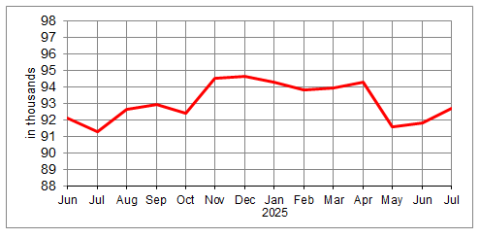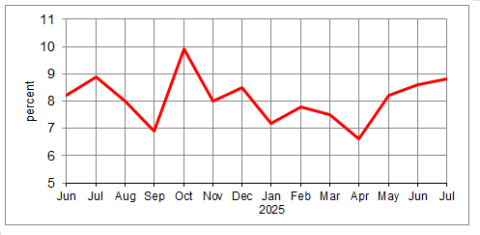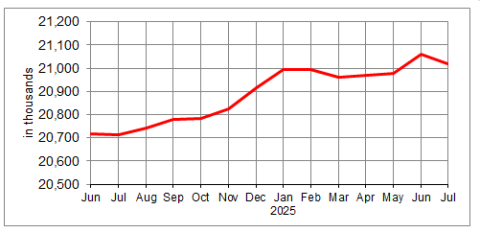Labour Force Survey, July 2025
released August 8, 2025
Prince Edward Island Employment

Unemployment Rate By Province (seasonally adjusted, in percentage)
| Month | Can | NL | PE | NS | NB | QC | ON | MB | SK | AB | BC |
| July 2025 | 6.9 | 10.5 | 8.8 | 7.0 | 7.5 | 5.5 | 7.9 | 5.5 | 5.0 | 7.8 | 5.9 |
| June 2025 | 6.9 | 9.9 | 8.6 | 6.7 | 7.3 | 6.3 | 7.8 | 5.5 | 4.9 | 6.8 | 5.6 |
| July 2024 | 6.4 | 9.5 | 8.9 | 7.0 | 7.1 | 5.6 | 6.9 | 5.8 | 5.3 | 7.1 | 5.7 |
| Year-over-year change (pp) | 0.5 | 1.0 | -0.1 | 0.0 | 0.4 | -0.1 | 1.0 | -0.3 | -0.3 | 0.7 | 0.2 |
| Monthly change (pp) | 0.0 | 0.6 | 0.2 | 0.3 | 0.2 | -0.8 | 0.1 | 0.0 | 0.1 | 1.0 | 0.3 |
Summary
Statistics Canada’s LFS shows P.E.I.’s seasonally adjusted employment in July totaled 92,700, an increase of 1,400 from one year ago and up 900 from last month. Employment in July increased across all broad age groups compared to June 2025. The seasonally adjusted unemployment rate was 8.8 percent, down 0.1 percentage points as compared to July 2024 and up 0.2 percentage points compared to June 2025. The total labour force totaled 101,600 in July. This is up 1,400 (1.4 percent) compared to July 2024 and up 1,200 (1.2 percent) compared to June 2025. The participation rate was 65.8 percent in July, up 0.6 percentage points from June.
The year-over-year increase in employment was wholly due to an increase in full-time employment of 1,400 (1.8 percent), while there was no change in part-time employment. Full-time employment totaled 80,400 in July, while part-time employment was 12,300. The services sector saw a decrease of 400 as compared to July 2024, while employment in the goods-producing sector rose by 1,700 over the same period (see table below for year-over-year employment gains and losses by industry), to total 68,600 and 24,100 respectively.
Employment gains (+)/ losses (-) between July 2024 and July 2025 occurred in the following sectors on Prince Edward Island1:
| Goods-producing sector | 1,700 | Service-providing sector | -400 | |
| Agriculture | -700 | Trade (Retail/Wholesale) | -800 | |
| Other Primary Industries | 300 | Transport & Warehousing | -600 | |
| Manufacturing | 1,100 | Finance, Insurance, Real Estate | 100 | |
| Construction | 1,200 | Business Services | 100 | |
| Utilities | -200 | Professional, Scientific and Technical | 600 | |
| Educational Services | -100 | |||
| Health & Social Services | 2,200 | |||
| Public Administration | -400 | |||
| Information, Culture and Recreation | -100 | |||
| Accommodation & Food services | -500 | |||
| Other Services | -1,200 |
The number of unemployed people in July on Prince Edward Island was 8,900, up 300 from one month ago and unchanged compared to July 2024. Long-term unemployment—the number of people who had been continuously unemployed for 27 weeks or more—was 1,100 in July, down from 1,600 in June. Expressed as a proportion of the total labour force, long-term unemployment was 1.1 percent in July, down from 1.6 percent in June.
PEI Unemployment Rate (Seasonally Adjusted)

According to the Labour Force Survey, year-over-year growth in PEI’s population aged 15 years and older was 1.8 percent in July. The employment rate—the proportion of the population aged 15 years and older who are employed—can help assess whether employment growth is keeping pace with population growth. In July, PEI’s employment rate was 60.1 percent, down 0.1 percentage points from July 2024. This indicates that growth in population year-over-year has outpaced employment growth over this period. The employment rate was at an all-time high of 63.0 percent in September and October of 2023.
The three-month moving average unemployment rate used by the Employment Insurance program for the Charlottetown region was 7.1 percent in July, no change from June. The minimum draw period and hours needed to qualify remain at 17 weeks and 630 hours for this region. The rate in the PEI region in July was 12.7 percent, up from 11.3 percent in June. The minimum draw period increases to 24 weeks and hours needed to qualify decrease to 455 for this region. For more information, please refer to Employment Insurance (EI) - Canada.ca.
NATIONAL
Nationally, employment decreased by 40,800 in July 2025 as compared to June 2025. The unemployment rate remained unchanged at 6.9 percent. The national employment rate decreased by 0.2 percentage points to 60.7 per cent in July.
At the industry level, employment in the goods-producing sector decreased by 29,000 (-0.7 percent) as compared to last month, while employment in the services-producing sector decreased by 11,900 (-0.1 percent). Provincially, seasonally adjusted employment in July increased in Saskatchewan (0.6 percent), while it fell in Alberta (-0.6 percent) and British Columbia (-0.5 percent). There was little change in the other provinces.
National average hourly wages for employees rose 3.3 percent ($1.17) on a year-over-year basis in July to reach $36.16. By province, year-over-year wage growth was highest in July in Nova Scotia (4.2 percent; $1.30), Manitoba (4.1 percent; $1.24) and Newfoundland and Labrador (3.9 percent; $1.23). Prince Edward Island saw the only year-over-year decrease in the average hourly wage, falling 1.4 percent (-$0.40). PEI’s average hourly wage remains the lowest among provinces at $29.02 in July.
Unadjusted for seasonality, the national three-month moving average unemployment rate in June was 7.0 percent. The rate for population groups designated as visible minorities was 9.3 percent. Visible minority groups for which the rate was higher than the average were Arab Canadians at 12.7 per cent, West Asian Canadians at 12.5 percent, Black Canadians at 12.0 percent, and South Asian Canadians at 9.4 percent.
Canada Employment

1 Components may not sum to total due to rounding
Notes:
1. The LFS estimates for June are for the week of July 13 to 19, 2025.
2. The LFS estimates are based on a sample and are therefore subject to sampling variability. For more information, see the Statistics Canada publication "Interpreting Monthly Changes in Employment from the Labour Force Survey."
3. The next release of the LFS will be on September 5, 2025.
Source: Statistics Canada, Labour Force Survey Estimates, released August 8, 2025.
For more information and links to data tables, refer to the Statistics Canada Labour Force Survey release for July 2025.
Related downloads for this release:
Monthly Labour Force Survey report - PDF (100KB)
